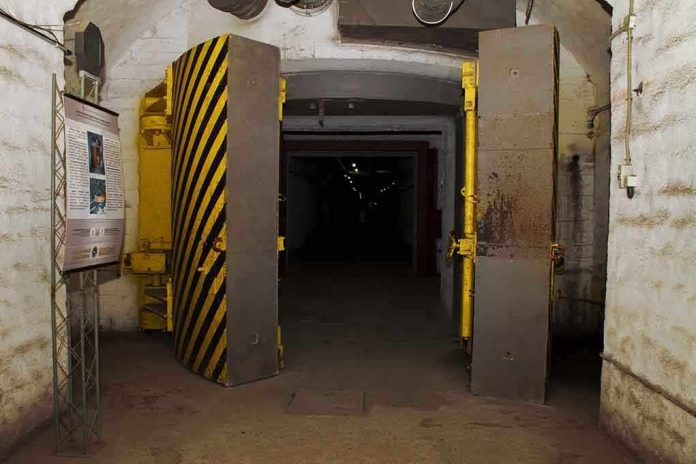
While Switzerland arms its citizens with bunkers, America must never surrender its constitutional defenses to government overreach or globalist threats.
Story Highlights
- Switzerland invests $250 million to modernize 360,000 bunkers, ensuring shelter for its entire population.
- Renewed global security concerns after Russia’s invasion of Ukraine drive this civil defense overhaul.
- Swiss policy prioritizes self-reliance and preparedness, with lessons relevant for defending American values.
- The program balances military readiness, disaster response, and technological innovation without eroding civil liberties.
Switzerland’s Bunker Overhaul: A Model of Civil Preparedness
Switzerland, famed for its armed neutrality, is investing approximately $250 million over 15 years to modernize its vast Cold War-era bunker network. The plan upgrades 360,000 protective shelters—enough to house every Swiss citizen. This unprecedented scale stems from a 1963 law requiring nuclear shelters in all new buildings, reflecting a long-held commitment to national self-sufficiency. The initiative responds to heightened security concerns following Russia’s invasion of Ukraine, emphasizing that preparedness is a duty, not a panic-driven reaction.
Switzerland’s approach stands out in Europe: while other nations scramble to repurpose old bunkers, Swiss authorities focus on both military and civil applications. From disaster response to secure data storage, the shelters’ multipurpose design preserves community resilience without sacrificing individual liberty. The government’s strategy prioritizes larger public shelters and technological upgrades, consolidating resources and ensuring ventilation and infrastructure meet modern standards. Officials stress that these measures protect lives while upholding the country’s tradition of decentralization and local control.
Historical Foundations and Contemporary Relevance
The origins of Switzerland’s bunker system trace back to Cold War anxieties and the doctrine of armed neutrality. During World War II, the National Redoubt fortified strategic mountain passes like Gotthard, embedding a culture of readiness. By the 1990s, when the Soviet threat faded, many bunkers were decommissioned or repurposed, highlighting the flexibility of Swiss civil defense. In recent years, inspections revealed aging infrastructure, especially in small private shelters, prompting a shift toward robust, technologically advanced public facilities. This evolution underscores a lesson for Americans: infrastructure investments should serve the people, not government overreach or centralized power.
Swiss civil defense demonstrates the value of empowering local communities and private sectors. Cantonal authorities administer shelters, adapting them for local needs—including housing refugees during crises. The Swiss Society for Technology and Armed Forces (STA) actively solicits innovation from private firms, ensuring upgrades enhance preparedness without sacrificing efficiency or liberty. Such collaboration contrasts with top-down or “woke” government programs that often erode personal freedoms in the name of safety or equity. America’s commitment to limited government and individual rights finds a clear parallel in Switzerland’s decentralized civil defense approach.
Stakeholders and Strategic Decisions
The bunker modernization project involves a coordinated effort among the Swiss Federal Government, the Federal Office for Civil Protection, the Swiss Army, cantonal authorities, and private sector innovators. Military and civil authorities collaborate, with distinct priorities for defense readiness and community protection. Decision-makers like the Swiss Army Chief and Federal Office for Civil Protection drive the technical direction, while innovation events encourage cross-sectoral input. This model illustrates how preparedness need not come at the expense of liberty or constitutional safeguards—a principle that remains vital as America resists bureaucratic overreach and protects its values.
Switzerland’s investment in civil defense is not merely about infrastructure; it’s a statement of cultural resilience and rational policy. The program’s short-term impact includes heightened public awareness and immediate upgrades to critical facilities. Long-term, the nation gains enhanced resilience against military threats, natural disasters, and technological hazards. The economic effects extend to private sector contracts and innovation, while social impacts reinforce a culture of self-reliance—a sharp contrast to the dependency and fiscal mismanagement seen in leftist agendas. Switzerland’s experience shows how prudent investment and local control can safeguard security without undermining freedom.
Implications for American Conservatives
As Switzerland revamps its bunkers, Americans must remain vigilant against any policy that erodes constitutional rights under the guise of national security. The Swiss model emphasizes preparedness, local empowerment, and strategic investment—values that resonate with conservative principles. In a world of mounting threats, America’s defense must remain rooted in liberty, limited government, and the inalienable rights enshrined in our Constitution. Swiss civil defense teaches that resilience comes not from surrendering control, but from investing in the people and preserving the freedoms that make a nation strong.
Sources:
The Rio Times: Swiss Preparedness – Modernizing Bunkers for 8.7 Million People
Eurasian Times: Highest Nuclear Bunkers Per Capita – Switzerland
Euronews: Switzerland Revives Wartime Bunkers Amid Heightened Security Concerns
Newly Swissed: Switzerland Fallout Shelters







